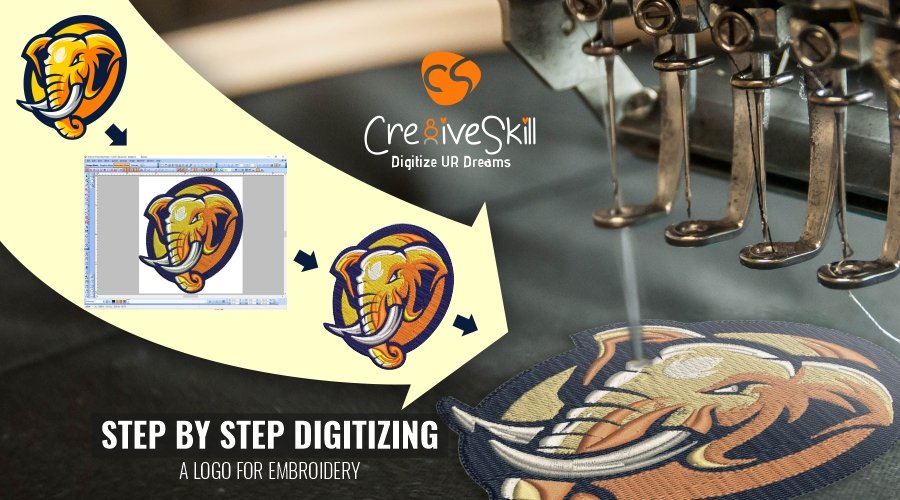Trustworthy Digitizing for Embroidery: Trusted by Experts
Trustworthy Digitizing for Embroidery: Trusted by Experts
Blog Article
Grasping the Needlework Digitizing Refine: Your Ultimate Guide
Embroidery digitizing is a thorough craft that calls for accuracy and expertise to equate intricate layouts into digital styles for device needlework. As craftsmens embark on this journey to grasp the embroidery digitizing procedure, a comprehensive understanding of the essentials sets the structure for excellence. Beyond the fundamental knowledge lies a world of sophisticated software, specialized devices, and nuanced techniques waiting to be checked out. By diving into the subtleties of digitizing, one can open a globe of creative possibilities and elevate their embroidery tasks to new elevations.

Understanding Needlework Digitizing Essentials
Needlework digitizing essentials create the structure whereupon intricate layouts are equated into machine-readable layouts for precise sewing. This preliminary step in the needlework digitizing procedure is important for making sure that the last stitched item is a devoted depiction of the original design. Comprehending needlework digitizing basics includes understanding vital ideas such as stitch types, sew instructions, density, padding, and pull compensation.
Stitch types play a vital role in figuring out the aesthetic and textural result of the embroidered design. By selecting the suitable stitch kind, whether it be satin, fill, or running stitch, digitizers can accomplish the desired result and boost the general high quality of the needlework. In addition, sew direction influences the circulation and dimension of the style, while density establishes the spacing and protection of the stitches.
Additionally, underlay stitching gives stability to the style by protecting the textile and stopping distortion during the embroidery procedure. Pull settlement is one more vital consideration to counteract the natural propensity of textile to contract when sewn. Mastering these embroidery digitizing essentials is fundamental for creating professional-quality embroidered items.
Picking the Right Digitizing Software
Choosing the ideal digitizing software program is a vital decision that substantially impacts the efficiency and quality of the embroidery digitizing procedure. Digitizing for Embroidery. When picking the ideal digitizing software, it is vital to take into consideration aspects such as the intricacy of designs you plan to produce, the user-friendliness of the software program, the degree of consumer support used, and the compatibility with your embroidery maker
There are numerous digitizing software application options readily available on the market, ranging from fundamental programs for beginners to sophisticated software for professional digitizers. Some preferred choices consist of Wilcom EmbroideryStudio, Hatch Needlework Software, and PulseID. These software use a vast array of devices and functions to assist you produce intricate designs effortlessly.
Prior to choosing, it is recommended to explore the different software program alternatives via totally free trials or trials to identify which one best matches your needs. In addition, reading reviews and seeking recommendations from seasoned digitizers can provide important understandings into the strengths and weak points of each software application bundle (Digitizing for Embroidery). By carefully evaluating your needs and comparing the functions of various digitizing software program, you can make an educated option that improves your needlework digitizing process
Digitizing Tools and Strategies

Optimizing Design Setup for Needlework
Understanding the ins and outs of design settings is essential in accomplishing optimum cause the needlework digitizing process, building upon the structure laid by recognizing digitizing devices and strategies. When maximizing layout setups for embroidery, it is vital to take into consideration variables such as stitch kind, density, rug, pull payment, and registration. Sew kind choice impacts the overall feel and look of the design, with options like satin, fill, and running stitches offering various appearances and impacts. Density refers to the spacing and density of stitches, influencing the style's insurance coverage and sturdiness. Appropriate underlay stitching gives stability and avoids textile distortion, specifically for complicated designs or on elastic products. Draw settlement readjusts for material stretch throughout sewing, guaranteeing exact design duplication. Enrollment settings straighten different components of the layout precisely, keeping overall layout honesty. By fine-tuning these design settings, embroiderers can enhance the high quality and accuracy of their embroidered developments.

Troubleshooting Common Digitizing Issues
When running into common digitizing issues during the needlework procedure, it is necessary to understand the source and apply effective options quickly. One common problem is stitch density problems, where stitches may be too thick, causing the material to pucker, or as well thin, bring about voids in the design. Adjusting the stitch thickness setups in the digitizing software can aid solve this concern.
Another frequent challenge is string breaks throughout the needlework procedure. This can take place because of various reasons such as incorrect tension setups, plain needles, or making use of low-grade string. Making Recommended Site certain appropriate upkeep of the needlework device, including regular needle adjustments and stress modifications, can minimize the occurrence of string breaks.
Additionally, layout enrollment errors can cause misaligned elements within the needlework style. Inspecting the layout alignment in the digitizing software application and making essential modifications before sewing can help in avoiding this problem. By resolving these usual digitizing concerns immediately and successfully, you can make certain a smoother needlework process and premium see post completed items.
Final Thought
Finally, grasping the needlework digitizing procedure calls for a strong understanding of the fundamentals, the right option of software application, and knowledge of tools and strategies. Maximizing layout settings and repairing usual digitizing concerns are important action in making sure high-quality needlework results. By complying with these actions faithfully, one can achieve precision and efficiency in the digitizing process.
Report this page